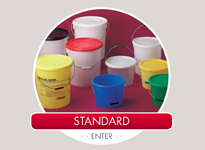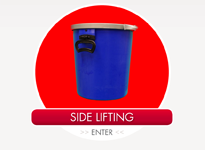
What are UN containers? (Part 3) Other tests.
June 21, 2012 at 2:38 PM
Although drop testing is one of the most intensive tests that containers must undergo, it is no more important than the other stages in determining UN standards.
Stacking Test (all types of packaging except bags):
This is required for all kinds of packaging, heavy duty buckets etc regardless of whether they contain a solid or a liquid. A force is applied to the top surface of the packaging equivalent to the total weight of identical packages that may end up being stacked on it during transit. The minimum height of this stack, including test sample, must be three metres (ten feet). The test is quite extensive and lasts four weeks. It must also be performed at a temperature of no less than 40 degrees centigrade (104F).
Leakproof Test (covers all liquid packaging):
This test is carried out using compressed air or other suitable gases on any packaging that will contain liquids. The design qualification involves submerging the test container with a closure under water, whilst internal pressure is applied. This is carried out for at least five minutes with pressures ranging from no less than 3psi to 5 psi, dependent on which packing group the container falls into.
The containers will pass the test if no air leaks from them.
As well as this qualification test, a further production test has to be implemented on all containers designed to contain liquids. This production test ensures that all containers intended to carry dangerous liquids, are free from any manufacturing defects such as pinhole leaks etc. The test is usually applied with a leak-tester on the production line of that particular container. If this test isn’t implemented during production, the company can become liable for penalties or fines.
The Hydrostatic Pressure Test (covers all liquid packaging):
This is required for any packaging and industrial plastic containers that may be used to carry liquids. Its purpose is to ensure there’s no leakage due to vapour pressure build-up that my occur through a range of temperatures. As some chemicals can release a vapour that increases as the temperature changes, containers must be built to withstand the resulting internal pressure. A good example of this is petrol. As the temperature rises, petrol fumes expand, and this creates an internal pressure on the container.
The test involves filling the container to its prescribed level and then applying an internal pressure for a minimum of half an hour. This pressure needs to be continuous and even and be kept constant throughout the test period. A hydraulic pressure gauge is connected to the top of the receptacle and records the pressure.
The hydrostatic pressure rating for the packaging selection is depends on how the hazardous materials’ vapour pressure and temperature interact.
To determine if a container’s kPa rating meets the requirements for a dangerous liquid, two temperatures are selected to determine the vapour pressure.
There is one other, lesser known test called the Vibration Test. However this is rarely carried out and is still the subject of ongoing discussion. It hasn’t been formally adopted yet because research indicates that most of the impact of vibration during transit depends on the location of the container within the vehicle. For instance, if the container is carried right above the rear axle of a van or lorry, it would be subjected to a lot more stress than if it was placed between the front and rear axles. Unfortunately, there’s still no agreed simulation of this yet.
When all these tests (bar the vibration test of course) have been successfully completed, the testing body is then able to issue UN Certification and the manufacturer can include the appropriate UN marking on the container.
Add Pingback

















